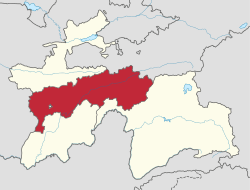Districts of Republican Subordination
Districts of Republican Subordination (Tajik: Ноҳияҳои тобеи ҷумҳурӣ, Nohiyaho‘i tobe‘i jumhurî/Nohijahoji toвeji çumhurī; Russian: Районы республиканского подчинения, Rajony respublikanskogo podčinenija) is a region in Tajikistan, consisting of 13 districts that are directly under central administration. The Districts' ethnic composition in 2010 was 85% Tajik and 11.7% Uzbek.[2]
Districts of Republican Subordination Ноҳияҳои тобеи ҷумҳурӣ ناحیه های تابع جمهوری | |
|---|---|
 Districts of Republican Subordination in Tajikistan | |
| Country | |
| Capital | Dushanbe |
| Area | |
| • Total | 28,600 km2 (11,000 sq mi) |
| Population (2019) | |
| • Total | 2,120,000 |
| • Density | 74/km2 (190/sq mi) |
| ISO 3166 code | TJ-RA |
| HDI (2017) | 0.641[1] medium |
| Wikimedia Commons has media related to Region of Republican Subordination. |
History
The Districts of Republican Subordination cover much of the territory of the Gharm Oblast which was dissolved in 1955.
They were formerly known as Karotegin Region.
Districts
The 13 districts are listed below roughly in their order of occurrence from west to east within the band forming the Region of Republican Subordination. The order of the districts and the district names are based on two consistent sources: an administrative map of Tajikistan[3] and a statistical yearbook showing the breakdown of RRP into districts.[4]
West Karotegin
- Tursunzoda District (formerly Regar District)
- Shahrinaw District
- Hisor District
- Rudaki District (formerly Leninskiy District)
Dushanbe City
Central Karotegin
- Varzob District
- Vahdat District (formerly Kofarnihon District)
- Faizobod District
- Roghun District
East Karotegin (Rasht Valley)
- Nurobod District (formerly Darband District)
- Rasht District (formerly Gharm District)
- Tavildara District
- Tojikobod District
- Jirgatol District
Geography
The plateau is traversed by the Vakhsh River, a right-hand tributary of the Amu Darya. On the northern border run the Gissar and Zeravshan mountains, and on the southern border the Darvaz range 7,600 metres (24,900 ft) . The area is 28,400 square kilometres (11,000 sq mi). The winter climate is extremely severe; snow begins to fall in October and it is May before it disappears. During the warmer months, however, the mountainsides are richly clothed with the foliage of maple, mountain ash, apple, pear and walnut trees; the orchards furnish, not only apples and pears, but peaches, cherries, mulberries and apricots. Both cattle and horses are of a small and hardy breed.[5]
References
- "Sub-national HDI - Area Database - Global Data Lab". hdi.globaldatalab.org. Retrieved 2018-09-13.
- "CensusInfo - Data". www.censusinfo.tj. Retrieved 2019-09-09.
- Republic of Tajikistan, map showing administrative division as of January 1, 2004, "Tojikkoinot" Cartographic Press, Dushanbe
- Agriculture of Tajikistan, Statistical Yearbook, State Statistical Committee of Tajikistan, Dushanbe, 2007
-
